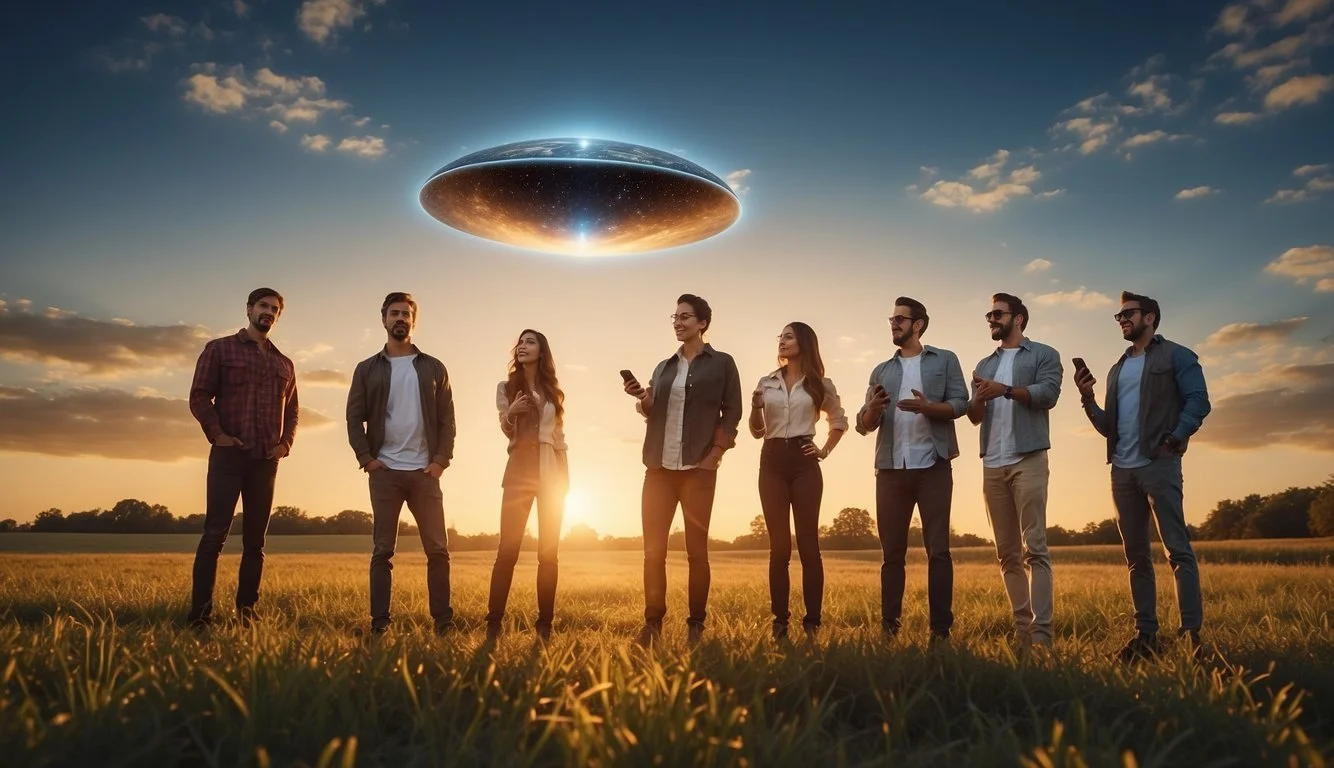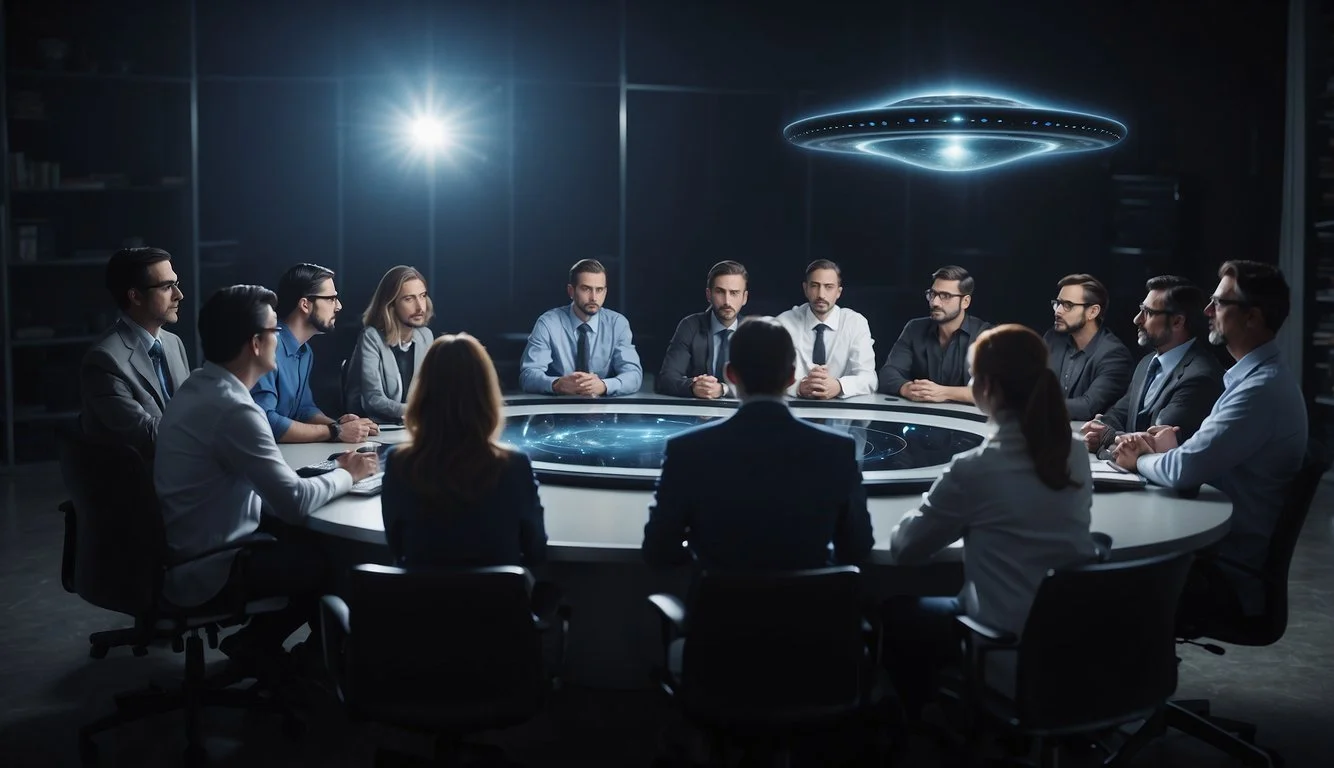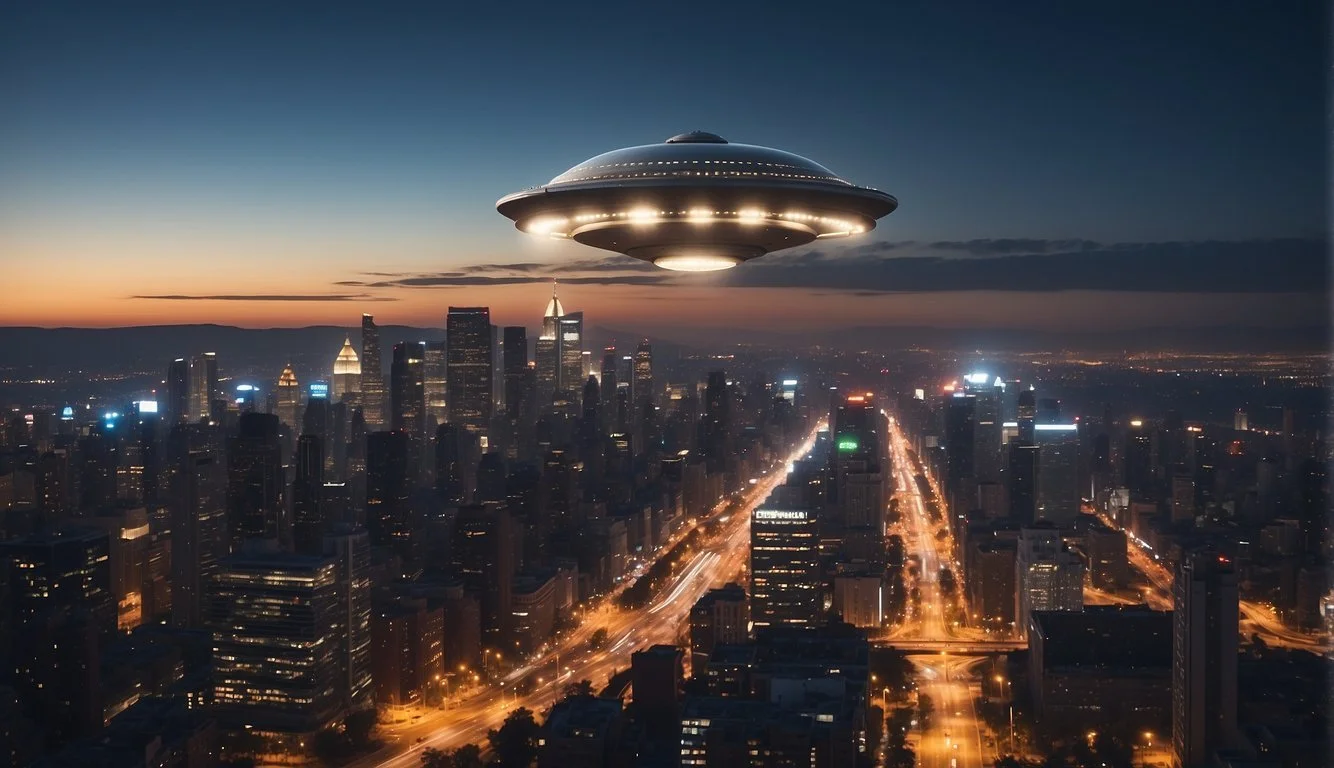The Role of Social Media in American UFO Sightings: Trends and Public Perception
The advent of social media has significantly impacted how Americans report and discuss UFO sightings. Platforms like Twitter, Facebook, and Reddit have become hotspots for sharing experiences and evidence of aerial phenomena that defy immediate explanation. These digital arenas not only facilitate the rapid dissemination of information but also cultivate communities deeply invested in the interpretation and understanding of these sightings. As eyewitness accounts and images circulate online, they often attract attention from both the public and researchers seeking to discern the nature of these occurrences.
Social scientists are examining this trend, noting that social media has altered the dynamics of UFO reporting. Where previously such incidents might have been relayed through official channels or confined to local word-of-mouth, social media allows for an immediate and broad broadcast of sightings. This can lead to a variety of results, including quicker validation or debunking of claims, as well as a more nuanced understanding of public sentiment toward unexplained phenomena. The collective scrutiny and debate that unfolds on social media platforms can also influence how seriously such sightings are taken and how they are framed within the broader cultural context.
The intersection of social media and UFO sightings presents a unique case study for American intrigue. As social platforms continue to shape discourse and public engagement, they also challenge traditional approaches to investigating and interpreting what many consider to be one of the last great mysteries of the modern era. Through the lens of social media, the American public is not just an audience to these strange sightings but active participants in shaping the conversation around them.
Historical Context of UFOs in America
The study of Unidentified Flying Objects (UFOs) in America has been deeply influenced by political developments and pivotal events, notably during the Cold War and the well-publicized Roswell incident.
The Cold War and the U.S. Government
During the Cold War era, heightened tensions and the race for technological supremacy between the United States and the Soviet Union led to an atmosphere ripe for UFO sightings and theories. The U.S. government, particularly the Central Intelligence Agency (CIA), often engaged in secretive research and had a vested interest in UFO sightings. They were considered potential Soviet advanced aerial technologies rather than evidence of extraterrestrial life.
Key Facts:
Government Agencies: The CIA and other military bodies monitored and investigated UFO reports.
Project Sign, Grudge, and Blue Book: Such investigations were often classified and shrouded in secrecy, fueling public suspicion and conspiracy theories.
The Roswell Incident and Its Aftermath
The Roswell Incident, a controversial and much-debated event, occurred in 1947 when an object crashed near Roswell, New Mexico. Initial reports by the U.S. Army suggested the retrieval of a "flying disk," but the statement was quickly retracted, and a narrative about a weather balloon was presented instead.
Impact on Public Perception:
Media Coverage: The incident received significant attention and became a staple of UFO folklore.
Speculations: Subsequent allegations of a government cover-up regarding the recovery of alien spacecraft and bodies intensified the political intrigue around UFOs.
The Roswell event and its aftermath have had lasting effects on the American public's perception of UFOs and the U.S. government, birthing a culture intertwined with notions of secrecy, suspicion, and the quest for disclosure.
Governmental Involvement and Public Perception
The intricate relationship between the U.S. government and UFO sightings has shaped public perception, with military encounters, congressional hearings, and intelligence reports playing pivotal roles.
Congressional Hearings and National Security
Congress has taken an active interest in unidentified flying objects, especially when they intersect with national security concerns. Notably, officials have convened Congressional hearings to evaluate the risks UFOs may pose. These dialogues often involve testimony from Pentagon representatives and seek to address the adequacy of current protocols in identifying and responding to potential aerial threats.
Military Encounters with UFOs
Reports of UFO sightings by military personnel have received significant attention from both the government and the public. These encounters, sometimes captured on video, have prompted the Pentagon to investigate and declassify certain events. The Air Force and other military branches are often at the forefront of these sightings, leading to a greater demand for transparency regarding unidentified aerial phenomena (UAP).
UFO Reports and Intelligence Agencies
Intelligence agencies have been tasked with compiling and assessing UFO reports. This includes evaluating the credibility of sightings and determining whether they can be attributed to foreign adversaries' technologies. The Unidentified Aerial Phenomena Task Force (UAPTF), established by the Department of Defense, exemplifies the ongoing effort to understand the UAP issue within a national security context.
The Role of Social Media in UFO Discourse
Social media has significantly altered the landscape of UFO discourse, serving as both a catalyst for community building among believers and skeptics alike, and a repository for immediate witness testimony.
Shifting Narratives and Believers' Communities
Social media has transformed how narratives around UFO sightings and alleged government cover-ups are crafted and disseminated. Platforms like Twitter, Facebook, and Reddit allow for the rapid spread of alleged sightings, fostering communities of believers who often share a distrust of official explanations. These online communities dissect incidents, share conspiratorial theories about possible UFO cover-ups, and create echo chambers that reinforce their beliefs.
Increased Skepticism: Users critique mainstream media's take on UFOs, promoting alternative explanations.
Community Validation: Eyewitnesses find support and corroboration among community members, encouraging more disclosures of sightings.
Social Media as a Platform for Witness Testimony
Social media enables direct witness testimony about UFO sightings, bypassing traditional media gatekeepers. Witnesses can instantly upload photos, videos, and narratives, often accompanied by location tags and real-time reactions.
Immediate Documentation: Platforms like Instagram and TikTok facilitate real-time sharing of evidence, adding credibility to claims.
Broader Reach: Witness accounts can go viral, reaching a global audience and inviting widespread scrutiny or support.
Engagement on social media around UFO sightings has created a dynamic public forum for debate, where sightings are not just reported but actively discussed and interpreted, altering the very nature of UFO discourse.
Scientific and Skeptical Views on UFOs
The discourse on UFO sightings often involves contrasting perspectives where scientific skepticism and rigorous scrutiny of evidence are paramount. This section examines the viewpoints of professionals in the scientific community and the role of scientific initiatives in the search for extraterrestrial life.
Expert Opinions and Social Scientists
Experts often approach UFO sightings with meticulous attention to detail, questioning the validity and origin of the evidence presented. Social scientists analyze the sociological impact of UFO sightings, considering how they influence public opinions and attitudes. They assess the level of confidence the public places in reports of unidentified aerial phenomena (UAP). Notably, some experts maintain that many UFO sightings can be attributed to natural phenomena or human-made objects, rather than to extraterrestrial sources.
SETI and the Search for Extraterrestrial Intelligence
SETI, the Search for Extraterrestrial Intelligence, is a scientific initiative dedicated to exploring the cosmos for signs of intelligent life beyond Earth. SETI researchers use advanced technologies to detect possible signals from distant civilizations, applying rigorous standards to ensure that evidence is credible and not a misinterpretation of natural cosmic events. The organization embodies a neutral position, acknowledging the vastness of the universe and the possibility of extraterrestrial life while maintaining that there is currently no definitive evidence to confirm its existence.
Cultural Impact of UFO Phenomena
The intrigue surrounding UFO sightings has permeated various aspects of American life, from entertainment to political discourse, shaping public trust and belief in the unknown.
UFOs in Popular Media and Politics
Popular Media:
Movies and Television: UFOs have been a staple of American cinema and television, often depicted as vehicles of extraterrestrial visitation. Classics like "Close Encounters of the Third Kind" and recent series like "The X-Files" reflect society's fascination with the possibility of alien life and the unknown.
Literature and Music: Books and songs have also contributed to UFO mythology, some offering speculative accounts of encounters, while others use UFOs as metaphors for political and social commentary.
Politics:
Government Statements: Recent acknowledgment by government officials of Unidentified Aerial Phenomena (UAP) has elevated the topic from fringe conspiracy theories to legitimate national security discussions.
Policy: There has been an increase in calls for transparency, leading to congressional hearings and the release of previously classified documents related to UFO sightings, especially those in restricted zones like Area 51.
Religious and Existential Implications of UFOs
Individuals and groups often integrate UFO sightings into their religious worldview, with some interpreting them as signs of divine or otherworldly intervention.
Debates have emerged over the compatibility of UFO phenomena with traditional religious teachings, influencing the spiritual beliefs of many.
Existential Questions:
Human Significance: UFOs challenge human exceptionalism, prompting questions about humanity's place in the universe. The potential existence of aliens has sparked both excitement and concern over what such a discovery implies about the human race.
Search for Meaning: The unexplained nature of UFOs has led some to reconsider the meaning of existence, pushing the boundaries of human understanding and acceptance of the unknown.
By examining the cultural influence of UFO phenomena, it is evident that their role in society extends beyond mere sightings, influencing media, politics, religious beliefs, and existential thought.
Contemporary Developments in Ufology
In recent years, developments in ufology have been significantly shaped by high-profile UFO sightings and the involvement of U.S. government agencies. Data transparency and technological advancements are key factors in understanding contemporary ufology.
Recent UFO Sightings and Pentagon Releases
The conversation around Unidentified Aerial Phenomena (UAP) has gained traction following the Pentagon's acknowledgment of several sightings. Notably, The New York Times played a pivotal role in 2017 by sharing footage of UAPs, leading the Pentagon to address the incidents publicly. In response, the Department of Defense established the UAP Task Force, which released reports providing insight into multiple encounters.
Key Developments:
2017: NYT releases UAP videos initially leaked by a former Pentagon official.
2020: The Pentagon officially publishes three Navy videos depicting UAPs.
2021: A report from the UAP Task Force is delivered to Congress with classified and unclassified versions.
Advancements in Aerial Reconnaissance
Recent strides in aerial reconnaissance technology have allowed for better identification and tracking of UAPs. NASA has recently become involved, appointing a team to study UAPs from a scientific perspective. Enhanced sensors, high-resolution cameras, and data analytics contribute to the increased detection and analysis of ambiguous aerial objects.
Technological Enhancements:
Sensors: Improved sensitivity for capturing high-speed objects.
Imagery: High-definition recording that captures detailed visual characteristics.
These advancements foster a more scientific approach to UAP investigation, allowing for more informed conclusions regarding their origins and behaviors.
Global Perspective on UFO Sightings
UFO sightings are not an American phenomenon alone; they are a global occurrence with each region offering unique insights. Europe stands out with its historical sightings, while military responses worldwide shed light on the issue's gravity.
European Incidents and Their Relevance
In Europe, incidents involving unidentified flying objects have been recorded and widely scrutinized. The UK's Ministry of Defence (MoD) released documents that trace UFO sightings over decades, revealing patterns that sometimes coincide with those in the United States. European authorities usually treat these incidents with a degree of skepticism, yet they also acknowledge the importance of understanding what they term as 'unexplained aerial phenomena,' especially when these intersect with national security concerns. For instance, in 2019, the Irish aviation authorities investigated reports of bright lights and UFOs spotted by several commercial pilots, underscoring the seriousness with which these incidents are occasionally taken.
Worldwide Military Responses to Unidentified Aerial Phenomena
Globally, militaries approach UFO sightings with caution and, sometimes, with a strategy that borders on secrecy. The U.S. Navy has formalized protocols for pilots to report unexplained aerial incursions, a move that reflects Washington's growing interest in understanding the potential threat posed by these phenomena. Similarly, foreign adversaries are suspected of having advanced aerial capabilities, often leading to speculation that some UFO sightings might be attributable to them rather than extraterrestrial origins. One notable response came from France, whose Geipan division of the national space agency investigates unidentified aerospace phenomena. These military and governmental responses highlight a dual concern: protecting the integrity of national airspace and identifying any foreign technology that may pose a strategic or tactical surprise.
Future of UFO Investigations
The American approach to UFO sightings is evolving, with a clear trend towards increased transparency and sophisticated surveillance technologies. This section will explore the anticipated advancements in public policy and aerial monitoring that are expected to redefine the landscape of UFO investigations.
Public Policy and Transparency
The US government's stance on Unidentified Flying Objects (UFOs), significantly influenced by the Office of the Director of National Intelligence (ODNI) reports, suggests an era of greater openness. One can anticipate a future where public policy mandates routine disclosures about UFO sightings, especially those involving military personnel. The intended effect is twofold: to diminish public skepticism and to formalize the government's commitment to addressing potential aerial threats. Such policies may include:
Mandatory reporting protocols for sightings by government and military personnel.
Regular declassification of previously withheld information on UFO encounters.
Technological Progress and Aerial Monitoring
Advances in technology play a pivotal role in the trajectory of UFO investigation methodologies. Emerging sensor and detection technologies are drastically improving capabilities for identifying and tracking anomalous aerial phenomena. Efforts may concentrate on:
Integration of AI-based analysis systems for real-time assessment of potential UFO encounters.
Deployment of advanced radar and satellite networks for comprehensive aerial monitoring.
These advancements not only promise better investigation outcomes but also the potential to protect national airspace more effectively.







